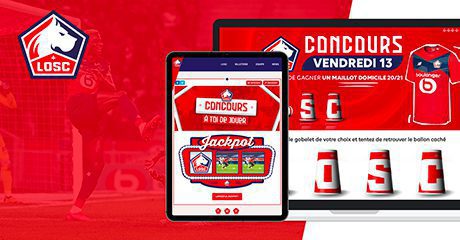Match day analysis: 3 trends influencing the sports industry
Like many other industries, the sports industry has been evolving at a breakneck pace in recent years. Advances in digital technology in particular are unlocking unprecedented growth and expansion opportunities for sports clubs and associations, allowing them to bring their fans closer to them with innovative and personalised experiences.
The world we live in is in constant motion and evolution, and one of the major challenges of all sports organisations is knowing how to adapt to these societal shifts, in an increasingly digitised world. This state of affairs highlights the importance of the one constant that the industry can always count on and need to keep at the heart of everything they do to ensure their sustainability and further growth: the fan.
In our e-book “The future is fan-tastic”, we take a deep dive into the sports industry and look at how the industry has a fan-tastic and fan-centric future. So keep your eye on the ball and read on if you’re looking to knock it out the park with your audience engagement, gamification and data collection strategy!

360° fan engagement
The sports industry is fundamentally an industry based on engagement and community, and the people who get involved with sports are passionate about it.
You only need to consider the mind-boggling number of fans who attend games and matches weekly around the world, or the breathtaking number of people who watch large-scale sporting events like the Olympics, the World Cup or the Super Bowl on television or online, to realise just how passionate and involved we all are!

So what exactly is fan engagement? Rui Biscaia, Senior Lecturer at the University of Bath, renowned for their sports departments, explains that fan engagement is so much more than likes and retweets on social media and defines it as:
the fans’ voluntary interactions with the team, either online or offline, that create value and imply having an emotional connection to the team.”
The concept of fan engagement was born in the 1990s in North America and has slowly made its way across the Atlantic, with social media and the rise of digital technology since the early 2000s being the main drivers. Clubs are now connected to their fans 24/7, with a multitude of contact points and communication channels, and regardless of where they are in the world.
Here are some great examples of sporting organisations listening to their fans and providing them with what they’re asking for and giving them more value and more personalised experiences:
- ⚽ Italian football club AS Roma launched their new website based on suggestions from their fans, making it more likely for them to see increased engagement .
- 🏟️ Manchester City’s Etihad stadium is equipped with free high-speed internet to allow fans to interact with the club’s social media channels during games.
- 🚴 The Tour de France now provides fans with up-to-date statistics and insights throughout the races, allowing fans to get a better understanding of what’s happening.
- 📲 Many clubs and organisations (English Cricket Board, West Ham United, Real Madrid, …) have launched fan apps that provide fans with a wide range of digital content and commercial outlets.

In their digital transformation report, the GSIC (Global Sports Innovation Center, powered by Microsoft) designated fan engagement as one of the key areas that sports organisations need to focus on between now and 2025, and the importance of fan engagement was given an average score of 6/7 in their survey.
The GSIC’s main objective is to connect innovation to the sports industry in order to improve its value chain, and they concluded that digital transformation is a key component of the sports industry nowadays and in the years to come, with fan engagement being the main benefactor.
Fan engagement remains one of the industry’s greatest challenges, especially in younger generations, who typically have shorter attention spans and rising expectations of the personalised and unique experiences they expect from their favourite club.
Generating revenue both from fans and sponsors in the sports industry
In an ideal world, the sports industry would be fuelled by the pure passion and enjoyment for sports, but we live in the real world and we all know that it actually all comes down to money. The New York Times estimates that the industry is worth $160 billion worldwide so the financial implications and weight of the industry are considerable.
Clubs need to create a brand that transcends the sport and they need to engage with their fans first to create a community, before generating revenue from them. It is important to not call fans ‘customers’ or ‘consumers’, they need to be treated as valuable guests who are interacting with a brand.
There are 3 traditional pillars for revenue in sports:

All three of these pillars are being put under considerable pressure in an increasingly digitised world, so it is key for sports organisations to always be finding new sources of revenue.
In the case of football, and especially big European clubs, fan bases are often spread worldwide, think of clubs like Liverpool, Manchester United or Real Madrid who have massive audiences in Asia and America for example. It is key for clubs to build meaningful relationships with these global audiences as they have the potential to generate more money from sponsors, who are always keen to reach large scale audiences. Hence the need for digital fan engagement solutions that sponsors can get on board with.
Digital engagement with fans will be key for the future of sport clubs, as they shift towards a more media-focused model where fan engagement can be monetized. The hole-in-one will be finding a way to drive fan engagement and create sponsor value from it in a non-intrusive and meaningful way. Collecting first- and zero-party data is a great way to do this – as clubs will be able to progressively ask their audience for data, then allowing them to personalise their content. And the use of interactive marketing to do so is proving to be a particular successful strategy.
Before being able to generate any revenue from fans, clubs need to understand them first, in order to give them the content and experiences they’re expecting. This means having a well thought-out and organised first- and zero-party data collection strategy in place.
When interviewed recently, Barcelona FC board member Didac Lee said
Content should be the new core business of clubs”
The revenue currently being generated from fans is tiny compared to the potential revenue. So just like consumer brands do with their audiences, sports clubs and organisations need to be collecting first- and zero-party data from their fan base in order to understand them by analysing their wants and needs. They need to be building a community because sponsors will always view a connected and engaged fan base favourably.
Brands that are willing to invest in sports and in sponsorship deals want to work with organisations that can effectively reach their audience, so having a solid direct-to-fan marketing and merchandising strategy in place and being really good at reaching your audience will increase your value in terms of sponsorship revenue.
There is an argument that says that aren’t fans already paying enough for tickets, shirts, TV subscriptions? Should clubs really be asking for more? Well not every fan is willing to spend money on their favourite clubs but there is a significant proportion of the fan base that are on the lookout for opportunities to do so. But if clubs aren’t in touch with their fans and don’t actually know what they really want, then they’re missing out on revenue opportunities. The key is making fans feel like part of a community, and not considering them as a revenue stream, but as people that are connected to you.
Loyal, retained & returning fans
Picture this: you’re standing in a half-empty stadium watching a rugby match in the depths of winter in January in the north of Europe. It’s lashing down with rain and the temperature is hovering somewhere below freezing. You’re soaked and can’t feel your toes. It’s a cracking game and your team won, but it sounds a bit grim, doesn’t it? So it makes sense that you’d rather be at home watching the game from the sofa with a warm drink, or in a pub with your mates and a pint, right?
Well this is precisely one of the major challenges facing sports federations and organisations in the next few years: how to keep fans returning to stadiums to watch live sport, given that it is so easy and readily available to watch from the comfort of your own home. Clubs are going to have to work extra hard to keep their fans engaged and coming back to stadiums and venues.
Fans are increasingly asking for more than just the game, they want exclusive and engaging experiences on top of the excitement and passion of watching a game. Forbes took a look at the example of the FA, the English Football Association, who trialled innovative engagement platforms to counter the effects of audience decreases during the COVID-19 pandemic. And the results speak for themselves: an initiative launched to encourage young girls to start playing football resulted in 60.000 new participants.
The GSIC pointed out in their report that technology is reshaping the sports industry’s future and there is an increasing tendency to redefine live sporting events as entertainment, with a new term even being coined “sportainment”. This means that clubs, organisations, federations and associations worldwide will have to work hard to keep up with the advances made thanks to technology or run the risk of lagging behind and losing out on growth and revenue opportunities.
Loyalty will play a big part in this, but it’s not enough to take a fan’s passion-based loyalty for granted. Their loyalty is based on an emotional connection, not a commercial one. Clubs therefore need to be careful not to be blindsided by fans’ loyalty and the potential revenue it could entail, at the expense of establishing a meaningful relationship with their fanbase.

Curious to find out more about the massive impact that fan engagement, sponsorship revenues, loyalty and new technologies are having on the sports industry? Then look no further and read our sports e-book – COME ON YOU … (insert favourite team name)!









